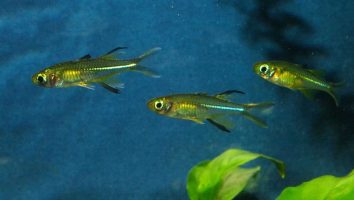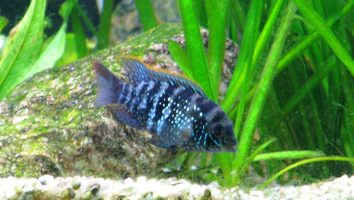The shadow catfish is a peaceful and hardy freshwater fish that does well in a community tank.
This species is known for being very active and playful, and they’re often seen “hanging out” with other fish in the tank.
Shadow catfish are also very easy to care for, making them a great choice for beginner fishkeepers.
In this guide, you’ll learn everything you need to know about shadow catfish care. Tank size, diet, tank mates, and more.
Table of contents
Species overview
Shadow catfish (scientific name: Bagrichthys macracanthus) are found throughout Southeast Asia in countries like Thailand, Laos, Cambodia, and Vietnam.
They prefer still or slow-moving waters with a lot of vegetation. This could be in the form of plants, roots, or leaf litter.
Like many other tropical fish, shadow catfish are omnivorous and will eat a variety of things. In the wild, their diet consists of small invertebrates, plants, and detritus.
In the aquarium trade, these fish are popular because of their unique appearance. They have a long, eel-like body and are brown with black markings.
They are also a relatively peaceful species, which makes them a good choice for many community tanks.
Appearance

The first thing you’ll notice about the Shadow Catfish is their unique coloration. These fish are a dark grey color that looks almost black in certain light. This color is solid all over their body with a slightly lighter belly.
The fins on this species are very typical for a catfish. The dorsal fin is short and starts about two-thirds of the way back on their body. The second half of the dorsal fin has a very sharp sting to it.
Their anal fin is shorter than the dorsal fin and starts closer to the middle of the body. The caudal fin is forked and relatively tall.
The pectoral fins on the Shadow Catfish are very long and thin. These fins are almost as long as their entire body!
This species has very long barbels (whiskers) that protrude from their face. They use these barbels to help them find food in the dark waters they inhabit.
Lifespan
The average lifespan for a Shadow Catfish is between 2 and 5 years. As with any fish, there are a number of factors that can impact their lifespan.
One thing to keep in mind is that these fish are very sensitive to changes in their environment. Even small fluctuations can cause stress which can lead to health problems and a shortened lifespan.
Another thing to consider is that Shadow Catfish are often wild caught. This means they’re not used to the rigors of life in captivity. As a result, they may not adjust well and have a shorter lifespan than their captive-bred counterparts.
Size
A full-grown Shadow Catfish can reach a length of about 4 inches, with most adults averaging closer to 3 inches. This makes them a relatively small species of fish, which is one reason they’re so popular among aquarium hobbyists.
Tank
Tank Size
The minimum tank size for shadow catfish is 24 inches (60 cm) in length. This is assuming you’re keeping them in a school of at least 5 or 6 fish (which you should).
We personally recommend a slightly larger tank if you can accommodate it. Every extra space will make a big difference and allow you to keep a larger school or more tank mates if you’re interested in a community tank.
Water Parameters
The shadow catfish is a hardy freshwater species that does best in slightly acidic to neutral water. They’re found in slow-moving streams and rivers with plenty of vegetation.
While they’re not as sensitive as some other fish to changes in water parameters, it’s still important to maintain consistency. Frequent water changes and testing will help you keep a close eye on things.
Here are some general guidelines for shadow catfish care.
- Water temperature: 72 to 82 degrees Fahrenheit
- pH levels: 6.0 to 7.5
- Water hardness: 5 to 20 dGH
- Alkalinity Levels: 3-10 dKH
What To Put In Their Tank
In the wild, these fish are found in slow-moving streams with a sandy substrate. This is what we recommend you recreate in their aquarium.
The addition of some plants can help to provide some hiding places and give the tank a more natural look. There are a few different species that do well in these conditions (Java Fern, Anubias, and Cryptocoryne are all great choices).
As for other decorations, a few pieces of driftwood or some smooth rocks can help to add some visual interest to the inside of their home. Just make sure that anything you add is securely in place. These fish are known for their ability to burrow and they will move things around if they’re not anchored down.
Common Diseases
The Shadow Catfish is a very hardy and robust fish. They’re not very prone to diseases, and can even handle less-than-ideal water conditions for short periods of time.
However, that doesn’t mean that they’re immune to sickness. If the water quality in their tank is poor, or if they’re exposed to a disease, they can certainly get ill.
The most common diseases that these fish experience are the usual freshwater culprits. Ich is the most common, but various other infections and parasites can strike too.
Be on the lookout for anything out of the ordinary so you can act fast. White spots, scars, cuts, or a change in behavior are all causes for concern. Even a disease that isn’t very severe can progress into something serious if left untreated.
When you notice something it’s important to act fast. Consult your vet and begin treatment immediately. The sooner you act, the higher the chance is that your fish will recover.
Of course, the best way to keep the risk of disease low is by simply keeping the tank in great shape. Not providing clean, high-quality water conditions will significantly increase the chance of your Shadow Catfish getting sick.
Behavior & Temperament
Shadow catfish are nocturnal creatures that spend most of their time hiding in the dark recesses of their tank. They’re relatively peaceful fish, but they can be a bit shy around others.
Because they’re nocturnal, they’re most active at night. This is when they’ll come out to feed. During the day, they’ll remain hidden away.
One of the best things about shadow catfish is that they’re very easy to care for. As long as you provide them with a hiding place and some food, they’ll be happy.
Tank Mates
The shadow catfish is a peaceful, bottom-dwelling fish that does well in community tanks. These fish are shy and prefer to stay hidden most of the time.
Because they’re not aggressive and don’t grow too large, there are plenty of tank mates that work well with shadow catfish.
Here are some compatible species to consider:
- Guppies
- Platies
- Mollies
- Swordtails
- Danios
- Tetras
- Corydoras Catfish
- Plecos
Breeding
The shadow catfish is a bit of a mystery when it comes to breeding in captivity. There have been reports of success, but not on a large scale. Plus, the process is very labor-intensive.
The first step is to sex the fish. Males have longer fins and a more slender body. Females, on the other hand, are rounder and have shorter fins.
Once you’ve determined the sex of your fish, you’ll need to set up a breeding tank. It should be at least 30 gallons and have a sandy bottom. The water should be between 75 and 80 degrees Fahrenheit.
You’ll also need to add some plants and driftwood to the tank. These provide hiding places and help to make the fish feel more comfortable.
When everything is ready, add two females for every male. The fish will need time to acclimate, so give them a few days before you start the spawning process.
To trigger spawning, you’ll need to make a few changes to the water. Lower the pH to 6.5 and the hardness to 5 dGH. You should also raise the temperature to 82 degrees Fahrenheit.
Once the conditions are right, the fish will start to spawn. The female will lay her eggs on the plants or driftwood, and the male will fertilize them.
After spawning, the eggs will hatch in about three days. The fry will be very small, so you’ll need to feed them live foods. Baby brine shrimp or microworms are good options.
As they grow, you can start to introduce other foods. Keep an eye on the fry, as they’re susceptible to diseases. If you see any fish acting strangely, remove them from the tank immediately.
Conclusion
Shadow catfish are a great addition to any freshwater aquarium. They’re relatively easy to care for, get along well with other community fish, and add a touch of darkness and mystery to your tank with their unique coloration.
If you’re looking for a fish that is low-maintenance but still interesting and visually appealing, the shadow catfish is a great choice.
We hope you’ve enjoyed this guide and that you now feel confident enough to add a shadow catfish to your tank. Thanks for reading!












